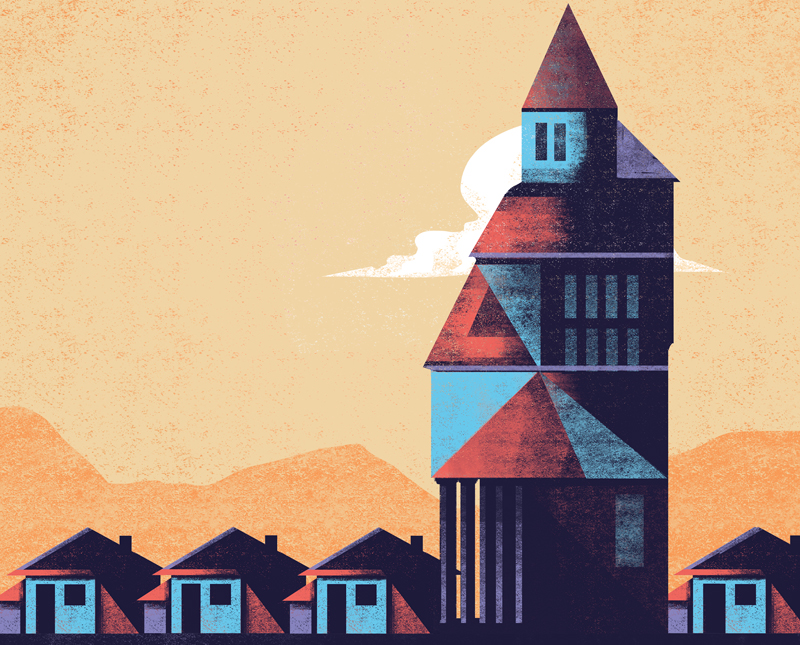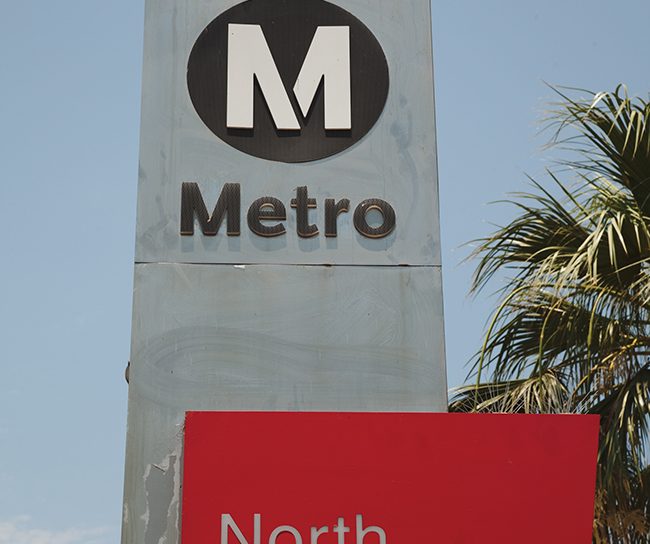
The Mansion Next Door
Is bigger really better? The debate over ginormous homes filling Valley lots reaches a fever pitch.
Clark Carlton’s days of nude sunbathing are over. Clearly unhappy, he blames “the McMansions” that were recently built next door.
“It affects sunlight, breezes and privacy,” Carlton quips, referring to the large, multi-level houses that flank both sides of his 1920s, one-story Spanish Colonial revival. “No more skinny-dipping for me—they look right into my yard.”
Carlton lives in North Beverly Grove, a small enclave off Beverly Glen on the other side of the hill. But in recent months he has been spending a lot of time helping activists in Sherman Oaks do what he has done in his own neighborhood: organize a fight against “McMansionization.”
The volatile issue, being debated across Los Angeles, pits neighbor against neighbor, wealthy against upper middle class and developer against homeowner. It involves hot-button topics such property owner rights, government overreach and masked racism—not to mention unattractive behaviors like showing off and “keeping up with the Joneses.”
Sherman Oaks
Following on the heels of more than a dozen other regions in LA, Sherman Oaks—with 60,000 residents—just became the largest community in the city to put temporary restrictions on the building of large-scale homes. While LA officials try to figure out how they’re going to handle restrictions on a citywide basis, the nation is watching.
“I’ve had people call us up from as far away as Canada,” Carlton says. “I’m from New Jersey, and it’s happening out there too. People all over are taking note of what we are doing about mansionization.”

McMansions—the derogatory term for monstrous, often poorly built, architecturally eclectic homes erected on average- or small-size lots—have cropped up at a rapid pace across the Valley, and it is easy to understand why. The Leave-It-to-Beaver and Brady-Bunch family homes, most of which were built in the ‘50s and ‘60s, now need updating—and for many homeowners that includes expanding. Children often stay at home into adulthood. Elderly parents live longer. And people now want home offices. The issue: How big is too big?
Take for instance the quaint, barn-red, ranch-style house that was razed in Encino at the corner of Hayvenhurst Avenue and Adlon Road several years ago. Now it’s a 10-bedroom, 12-bathroom, 11,700-square-foot structure on the market at $4.5 million. Towering at the edge of the sidewalk, the mansion is surrounded by homes less than one-fifth the size and valued at less than one-quarter the price. The home, which neighbors consider an eyesore, has been almost constantly on the market since the mansion was built.
Across the Valley in Colfax Meadows, there is another—a three-story, seven-bedroom, 10-bathroom, 12,500-square-foot house with no yard and master bedrooms larger than some of the homes nearby. Real estate agents who’ve represented it boast that the boxy structure is “the largest house in Studio City,” while many locals point to it as the worst example of the McMansionization in all of LA.

Studio City is something of a trailblazer. It was the first neighborhood in LA to get building restrictions passed. Activists, with the help of city councilman Paul Krekorian, got regulations on the books in 2008. (The “largest house in Studio City” got built legally a year later due to loopholes.)
Krekorian lives a few blocks away in Colfax Meadows. He sees the McMansionization issue as an example of how improvements of city laws still need to be made and how a one-size-fits-all ordinance doesn’t work in a city as diverse as Los Angeles.
“It’s a long-brewing issue, and I’m proud of the work we did with the community,” Krekorian says. “The trick is to deal not only with the size but with the environmental impact of the house and to encourage design elements that are not out of character with the neighborhood. Each community has its own different concerns.”
Nearby Valley Village has also implemented restrictions to curb McMansions. From a citywide standpoint, Krekorian points out that the “not-in-my-backyard” approach isn’t an ideal solution. When one community puts up restrictions, developers simply move on to build larger homes in other areas.
Rules in Play
Mansionization involves an alphabet soup of abbreviations. The city first passed a Baseline Mansionization Ordinance (BMO) in 2008 that wasn’t effective enough, so they passed Interim Control Ordinances (ICOs) temporarily for some neighborhoods where development was suddenly booming.
A Residential Floor Area (RFA) is the ratio of the house to the lot. The city’s Planning and Land Use Management committee (PLUM) spent most of this past year hearing input to compile an ordinance that would designate a permanent RFA. One of the more restrictive community measures currently available is a Historic Preservation Overlay Zone (HPOZ) designation, which allows a team of neighbors to review design plans.
“You have to find a way to deal with growing housing demand. There is an uptick in the number of homes being built and torn down,” says Krekorian, who adds that he has gotten inquiries across the country about the local activism. “It’s important that you don’t atrophy the character of a neighborhood.”
By the Numbers
Right now in Sherman Oaks, the ICO limits what property owners can build on a residential lot. On a 5,000-square-foot lot owners can’t build a house more than 50% of the size, or 2,500 square feet. For lots more than 7,500 square feet, buildings can’t exceed 45% or 3,750 square feet, whichever is greater.
Speaking of Size
Sherman Oaks’ new city councilman David Ryu insists he is trying to speed up the process and get the city to solidify the ICOs by April. Ryu, who won Tom LaBonge’s district seat last year, ran on a platform insisting that he would take no money from developers.
His redrawn district includes parts of Los Feliz and Hancock Park, where he lived most of his life, extending through the Hollywood Hills to Sherman Oaks. The council unanimously passed his proposal to include Sherman Oaks in the ICO restrictions, and his district has more ICO communities than any other part of the city.
Ryu points out, “The one thing that every sector of my district brings up is the McMansions popping up. I go to knock on a door in Sherman Oaks, and they’ll take me down the block to show me an example of something being built that is totally wrong for the neighborhood.”
Some McMansions are built by developers who hope to flip the property for fast profit. Others, according to the councilman, are the result of longtime residents forced to sell because they can no longer afford to live there, or they simply want bigger houses.
“I have to walk people through the process and show them that they can still add onto their homes,” Ryu explains. “I have a reputation for being anti-development, but what I want is appropriate development.”
He worries about a strain to infrastructure. Inadequate roads, frequent water main breaks and overcrowded schools all become big problems for Sherman Oaks as the houses get bigger.
Just ask John Isen of the Sherman Oaks Homeowners Association. “This continues to be one of the biggest issues that people complain about here, and David Ryu has answered the call to help us,” Isen says. One of the complaints, according to Isen, involved a street with about two dozen homes that recently had nine McMansions erected. People are getting angry.
The Other Side
Not everyone, though, is anti-McMansionization. “I’m definitely in the minority because I think people should be able to do what they want on their property, within reason,” says Jay Weitzler, a local attorney. Weitzler is on the SOHA board but emphasizes he is only speaking for himself.
“People want to hold onto the past, but desired values have changed and neighborhoods must change,” he reflects. He has lived in his house, built in 1957, for 37 years. “I’m not looking to expand my house right now, but I understand the need for people who want to do so. Nobody will buy a 1,300-square-foot home these days; it’s not realistic. If you want to keep the status quo, you won’t continue to uplift the area.”
Weitzler recognizes the impositions on some homeowners who don’t want people looking into their backyards. He will be the first to protest developments that take down trees, which he has seen happen on his own block.
Real estate developer David Cooper lives with his family in Valley Village, where some of the city’s newest regulations are in place. His company, Tamarindo Capital, has built larger homes in Encino and Sherman Oaks for the past five years.
“I think people don’t see how most of the time we’re making neighborhoods 100% better,” Cooper explains. “Some of the loudest activists are against any kind of development. Sometimes people don’t like the changing character of their neighborhood, but a lot of the change is for the better.”
And Cooper argues that the older homes are generally too expensive to renovate. “Most of the houses are old and dilapidated and would be very difficult to remodel,” he insists. “We are building typically to maximize the square footage. We also want to be connected to what is going on in the neighborhood.”
Developers, Cooper says, will avoid pockets of neighborhoods where they know they are not welcome. He points out a section in Sherman Oaks bounded by Moorpark and the Hollywood Freeway, Fulton and Coldwater Canyon Boulevard where signs on the front lawns protest McMansions.
“It brings jobs and better houses to the area,” Cooper says. “If we take a house that was once worth $1 million and rebuild and now it’s worth $2 million, how can that be bad?”
Then there is the issue of stereotyping. Cooper, who has a dual Israeli citizenship, says he has heard discrimination against Middle Easterners—painted as those who build and buy “Persian palaces.”
But Clark Carlton maintains stereotyping has nothing to do with his fight against McMansionization. He says that a lot of these larger homes are “new Americans” hoping to make a fast buck.
“Some are trying to make those of us protesting McMansions out as racists or xenophobes, but I don’t really care where they come from if they’re building or buying the house,” Carlton says. “But I do care if they are destroying the character of my neighborhood.”












